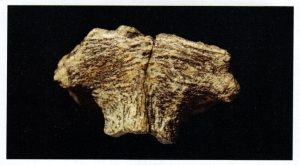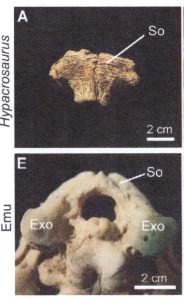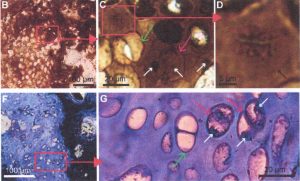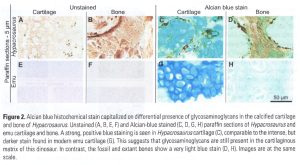The National Geographic Society over the decades has consistently held closely to the secular perspective in its treatments of history and science. This is seen in all articles in National Geographic publications by its devotion to deep time and macroevolution. Articles on dinosaurs in particular rely heavily on the telling of stories that appeal to our human appetites for mystery and adventure. Great effort is placed on splendid (fictional) paintings with imaginative details of things discussed in the dinosaur stories. These starting points in the Nat Geo articles mean that truth can be, and often is, sacrificed. In my opinion, most National Geographic stories about dinosaurs are aimed at the readership level of the fourteen-year-old child. Unfortunately, most children of that age have not yet learned the importance of critical thinking and tend to believe everything they read. Nat Geo knows this fact, and so fantastic dinosaur stories of this type are the usual result.
In 2024 Nat Geo published a book with the title, Dinosaurs—A New Look at the Prehistoric Icons.* I am writing this article as number four in a series on various parts of this Nat Geo book. My article #4 will cover the article in the book called “DNA in the Dinosaur’s Skull.” This particular article is another one written by Michael Greshko and was originally published on NationalGeographic.com on March 3, 2020, right after the study itself was published in January 2020.
In all secular dinosaur stories, the assumption of deep time is foremost. What is not ever explained is that the deep time is a foundational assumption and not a historical or scientific fact. The geological timeline was developed based on assumed jumps of one kind of life to the next evolved kind. Various guesses about how long these jumps might have taken are then added up to get the millions of years. Of course, no one has ever witnessed any of these assumed evolutionary jumps either in the present or in the fossils in the rock record. The ages of sedimentary rocks are then determined by the artificial predesigned order of the fossils in the geological timeline. This timeline and the principle of uniformitarianism are taken totally on faith by evolutionists. It is not science!
In the “DNA in the Dinosaur’s Skull” article an accurate description is given of the scientific effort done by six well-known paleontologists including Jack Horner and Mary Schweitzer whom most of us have heard much about. The science described seems pretty convincing to this non-expert in the processes used. Here is how the introductory sentence of the Nat Geo story reads: “The study…takes a close look at two juvenile skull bones from the hadrosaur Hypacrosaurus stebingeri, a plant-eating dinosaur that lived in what’s now Montana about 75 million years ago.”
I have to stop now to interject the fact that I plan to show that this study seems to indicate that the hadrosaur bones did indeed have something in them that should not be there according to conventional science. But the key to understanding that from a creationist perspective is to note the fundamental assumption that drives everything else inside the story. That assumption is shown in the sentence quoted above that includes the words, “75 million years ago.” Those are the words that make the telling of this story a real “whopper.”
Author Greshko continues, “Inside the tiny fossils, researchers can see what appear to be cells, some frozen in the process of dividing. Others contain darkened balls that look just like nuclei, the cellular structures that store DNA.” So, let’s next look at some of the pictures from the study.**
Figure of supraoccipital bone from skull of Hypacrosaurus dinosaur (about 2.4″ wide).
Hypacrosaurus bone compared to emu bone. (So = supraoccipital).
Here we see another presupposition, and that is that dinosaurs and birds would be expected to have similar supraoccipital bone construction. In this case I think that may not be a problem.
Figure 1 and its caption from the study.
If the caption above is carefully read and compared to sections A though G of the figure, a person would be able to see the hypotheses involved and understand that the photos do seem to indicate that there are similar cells and nuclei in both the ancient juvenile dinosaur and recent juvenile emu photos. Personally, I am not so convinced that that image D is really showing metaphase chromosomes, but again I am no expert. The images are shown larger in the next view.
Figure 1 expanded view.
In Figure 2 another test is shown that shows the similarities between the dinosaur and emu sections. In this case what are called histochemical stains are used to indicate the presence of glycosaminoglycans. Again, read the caption to get a feel for what the paleontologists are trying to say.
Figures 3 and 4 from the study.
Greshko continues, “To test the fossilized material, the researchers applied stains that bind to DNA in living cells to the bits of dinosaur skull. These stains stuck to particular spots within the fossil cells, making them glow in fluorescent red and blue. As far as the researchers can tell, whatever the stains are binding to derived from the dinosaur’s original molecules, not an outside contaminant such as bacteria.”
The study authors wrote the following in the abstract of the original paper: “Our data support the hypothesis that calcified cartilage is preserved at the molecular level in this Mesozoic material, and suggest that remnants of once-living chondrocytes, including their DNA, may preserve for millions of years.”
Please note the qualifying words “suggest” and “may.” And this research was not accepted well by many other secular paleontologists. Several of them responded immediately to the research with complaints that DNA cannot possibly last 75 million years according to all existing science. To the untrained person it would indeed seem ridiculous to think DNA could last even 100,000 years. But perhaps it could last several thousand years.
That is the crux of this story. If the secularists would accept the loads of biblical paleontological evidence that indicates that fossils can be no older than the 4,500 years since the global Flood at the time of Noah, they could all agree about what they see in their microscopes.
J.D. Mitchell
The fear of the LORD is the beginning of knowledge, but fools despise wisdom and instruction. (Proverbs 1:7 NIV)
*Dinosaurs—A New Look at the Prehistoric Icons, National Geographic Partners, LLC, Meredith Operations Corporation, New York, NY publisher, 2024.
**Original research is: “Evidence of proteins, chromosomes and chemical markers of DNA in exceptionally preserved dinosaur cartilage,” Bailleul, Zheng, Horner, Hall, Holliday, and Schweitzer, National Science Review 7:815-822, 2020.
Related CEC articles that you can find on this website:
- “Archaeoraptor Fraud.”
- “The Power of Presuppositions.”
- “Transitioning a Dinosaur into a Bird.”
- “Historical Certainty & Millions of Years.”









